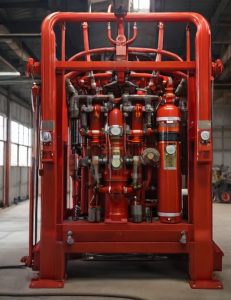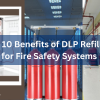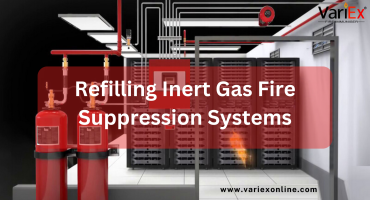![]()
Fire Immuniser
+91-7829629111
Email: info@variex.in
Varistor Technologies Pvt. Ltd.
Block-1, First Floor, Ardente Office One, Hoodi Circle, ITPL Main Road, Bengaluru, Karnataka 560048, IN
What Type Of Pump Is Suitable For Fire Fighting System
Firefighting systems play a crucial role in safeguarding lives and properties from the devastating impact of fires. One essential component of these systems is the fire pump, which provides the necessary pressure to deliver water or foam to extinguish fires effectively. But with various types of fire pumps available on the market, how can one determine which is suitable for a specific firefighting system? In this article, we will explore different types of fire pumps and discuss their suitability for various firefighting applications.
Centrifugal Fire Pumps
People commonly use centrifugal pumps in fire suppression systems due to their efficiency and reliability. They work by utilizing the centrifugal force generated by a rotating impeller to move water or foam. These pumps can achieve high flow rates and pressures, making them suitable for large-scale firefighting operations, such as commercial or industrial settings. The centrifugal pump's ease of maintenance and operation, as well as its adaptability to different fuel sources such as diesel or electric power, also adds to its appeal.
Centrifugal pumps are further classified based on their driver source, such as electric, diesel engine, or steam turbine. People usually favor electric-driven pumps for their simplicity and ease of integration into existing power systems. Diesel engine-driven pumps, on the other hand, offer greater mobility and independence from external power sources, making them ideal for remote locations or as backup systems.
Positive Displacement Fire Pumps
Positive displacement pumps function by trapping fluid within a set volume and then forcing it out under pressure. While less commonly used in firefighting applications, they excel in situations that require high pressure or when dealing with viscous liquids, such as foam.
One example of a positive displacement pump suitable for fire suppression is the reciprocating piston pump. This pump type delivers a consistent flow and pressure by using pistons to displace the fluid. Due to its design, reciprocating pumps can provide steady pressure even at lower flow rates, making them suitable for long-range water delivery, especially in high-rise buildings.
Another type of positive displacement pump is the rotary vane pump. It relies on rotating blades or vanes to create the necessary pressure. Rotary vane pumps offer higher flow rates compared to reciprocating pumps, making them ideal for situations that require large volumes of water, such as in municipal fire hydrant systems.
Axial Flow Pumps
Axial flow pumps differ from centrifugal and positive displacement pumps in their design and method of operation. Instead of using an impeller or pistons, axial flow pumps utilize propeller-like blades to move water or foam.
These pumps have high flow rates, ideal for large-scale operations like firefighting on open water bodies. Their ability to move water swiftly ensures rapid fire containment. Fireboats and aerial firefighting systems often integrate axial flow pumps for effective fire suppression.
Conclusion
When selecting the right pump for a firefighting system, one must consider various factors. The choice between centrifugal, positive displacement, or axial flow pumps depends on the specific needs of the situation. Centrifugal pumps excel in delivering high flow rates and pressures, making them suitable for commercial or industrial applications. Positive displacement pumps are ideal for high-pressure scenarios or when dealing with foam, while axial flow pumps are best for large-scale operations and open bodies of water.
Understanding various fire pump types and their suitability for firefighting is crucial. Consult experts for tailored advice. With the right pump, your system can confidently protect lives and property.
Frequently Asked Questions
Q1: What are the factors to consider while selecting a pump for fire fighting system?
The factors to consider while selecting a pump for fire fighting system include the required flow rate, pressure capacity, pump type, power source, and reliability.
Q2: What is the recommended flow rate for a fire fighting pump?
Local fire codes and regulations typically determine the recommended flow rate for a fire fighting pump. It is commonly around 500 gallons per minute (gpm) to ensure sufficient water supply during emergencies.
Q3: Which pump type is commonly used for fire fighting systems?
The most commonly used pump type for fire fighting systems is the centrifugal pump. It is highly efficient, reliable, and capable of delivering high flow rates and pressures.
Q4: Can a diesel-powered pump be used for fire fighting system?
Yes, diesel-powered pumps are commonly used for fire fighting systems. They offer a reliable power source and can operate independently of the electrical grid, making them suitable for remote or off-grid locations.
Q5: Should I choose a horizontal or vertical pump for a fire fighting system?
The choice between a horizontal or vertical pump depends on the available space and installation requirements. Both types can be suitable for fire fighting systems, so it is important to consult with a professional to determine the best option for your specific needs.
Final Say
We at VariEx.in or Variexonline.com have mastered the art of designing, installing, inspecting, and fixing automatic sprinkler systems with the help of our in-house team, which is capable of delivering the fire sprinkler services you need, whether large or small and at affordable cost.
To schedule a fire sprinkler installation, or you think our services could benefit your commercial property, contact us online or give us a call at, 7829629111










